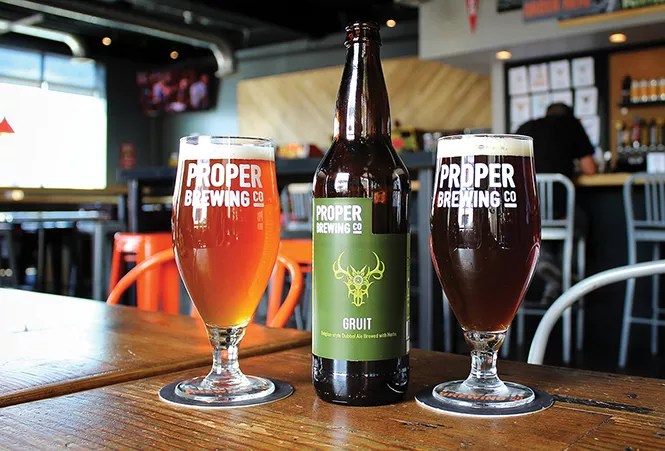
- Mike Riedel
It's all about the hops in America's beer world right now. However, a thousand years ago in continental Europe, the benefit of hops in beer was barely known, due to their geography and availability. Beers from that long-forgotten age were bittered with everything and anything an ancient brewer could get his or her hands on. It wasn't because they loved the taste of bitters; it was more about making the ales less sweet, along with the various medicinal effects.
Today, we refer to this style of beer as a gruit. These modern interpretations rely heavily on spices and berries to add flavors to the brew instead of the steadfast hop. The results can be a somewhat herbal and tea-like beer that has a bit of fruit or spice for balance. It's also said that gruits can be stimulating apart from the more common alcoholic influences, and can be helpful as a libido aid.
Proper Brewing Co.'s Brewmaster Rio Connolly and his crew took up the challenge to make not only one gruit, but two. Here are my impressions of these two very different ancient ales.
Proper Gruit: Pours a somewhat hazy walnut color with ruby highlights. The aroma brings notes of soft wheat, along with a moderate tart sweetness reminiscent of herbaceous apricot and mild yeast. Pine and lemon round out the semi-potent scent. The taste showcases the herbs more accurately, starting with cracker-like malts with a touch of peach and pear. Now the herbs begin to assert themselves, as the addition of yarrow spices creates a notable bitterness, with flavors of grass and licorice. The next flavor to emerge from the spice rack is from the Labrador tea; it adds flavors similar to regular black tea, but with more piney bitters. Finally the sweet gale emerges, adding note similar to ginger, mint and rosemary. The blend of herbs isn't too far off from some of the more mild-mannered European hops, and does a pretty decent job mimicking them. They provide adequate bitterness and flavor to round out the sweetness and yeast profile of this 8.5 percent ABV beer.
Overall: With all of the herb additions, it's far more accessible than I would have ever guessed. Many of the herbs used in lieu of hops generated very similar flavor profiles to hops, and a decent bitterness as well. I'd recommend that anybody interested in ancient-style ales try a gruit like this one.
Grow Wild Gruit: Our second example pours a murky mahogany brown, with a faint tan head that fades very quickly. The nose is intensely herbal with the wild sage taking over entirely. It's very fresh, but sharp. The taste is a little off the beaten path, with earthy, slightly metallic, herbal flavors shining through. Fresh horsemint takes over from here, adding a bright freshness that is cooling on the tongue. It's kind of off-putting at first, but becomes more enjoyable as the palate adjusts. Hiding behind the mint is a licorice-like sweetness and a somewhat bitter and astringent finish. I imagine this is something Tolkien's Shire folk would go mad for.
Overall: Despite the beer's modest 4.0 percent ABV, it's still a sipper due to the raw herbal madness that defines this brew's flavor and aroma—though it could use a bit more malt and yeast phenolics for sweetness and body. This is definitely a brew aficionados should try, and I applaud Proper Brewing Co. for bringing these ancient beers back into the light.
These herbalicious ales available right now at Proper Brewing and Avenues Proper. As always, skol!